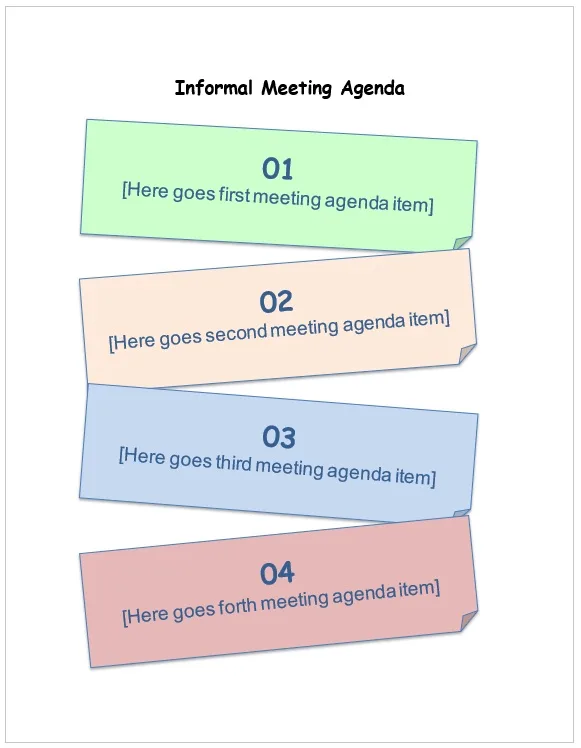An informal agenda template, as compared to a formal agenda template, is less complex and strict. There are many prominent features in the formal agenda template that are not a part of the informal agenda template. The most pronounced one is the proper agenda.
As in the formal agenda, there is a good reason for the meeting. But, in informal meetings, the meeting is informally carried out without any proper target. Also, no one chairs the meeting. Also, there are no meeting minutes in the informal agenda template. This type of informal meeting takes place at informal places, unlike formal meetings, such as restaurants, hotels, cafeterias, lawns, lounges, coffee shops, etc.
Importance of Informal Meetings
The main idea behind the informal meetings is basically to make the two persons, or maybe more, who are a part of that meeting feel comfortable. Everyone is free to speak without hesitation. In short, everyone is comfortable. This is why the organization of the informal meetings is easy because there is a formality to follow in it.
The main advantage of such types of meetings is that they allow the organizations to grow better as the workers have the free will to discuss the good and the bad things of the organization. It will help them to pinpoint them and improve them. This will help them in making a more stable and comfortable environment for working.
Understanding Informal Meetings
Informal meetings are these unplanned interactions that are a frequent occurrence and most appropriate to be conducted anywhere. These gatherings can be held in-person, over the phone, or even through video conferencing. Most importantly, in-office formal meetings are based on codes of views, attitudes, and formal documentation. On the other hand, informal meetings are easy-going. They allow talking, working, and attending to issues without any frustrations or stressful measures. They ‘protect the process’ in the sense that includes describing, calming down, and rationalizing so as to avoid unnecessary friction that would result from creating a hierarchy. Therefore, in either case, to explain the significance of informal meetings, it will be imperative to look into the features of the informal meeting and the circumstances under which it ought to be applied.
Characteristics Distinguishing Informal from Formal Meetings
The tone and conduct of interactions between the participants of an informal or a formal meeting depend on the nature of the meeting and form the most distinguishing factor between the two types. Informal meetings generally do not have an agenda or even people knowing where they are sitting for the next hour or so after the meeting starts. There may not be much planning before the meeting, if any, and all those in the meeting tend to take turns freely speaking as no turns or rules of etiquette are followed. Minutes or end-of-meeting summaries are generally absent, though follow-up activities might be conducted. This format allows participants to have more productive engagements which are vital especially in areas where creativity, collaboration, and high-speed decision making are vital.
Common Scenarios for Informal Meetings
Informal meetings, including daily standups or team huddles, usually occur for swollen reasons that need to check-ins or brainstorm solutions and not be later than meetings with topics that are easy to come with. This generally includes informal settings such as over a cup of coffee among colleagues which helps to sort out priorities or having a discussion about some issues. In such cases, it is mostly about getting straight away into the core issues at hand. Informal meetings work best because they are actionable and encourage the culture of team communication more than writing emails.
Benefits of Informal Meetings in Organizational Settings
As relaxed as they may seem, there are certain strategic advantages associated with informal meetings as well. For one, they assist in the development of interpersonal relationships, eliminate communication gaps and encourage employees to communicate without any pressure. In turn, the overall work environment becomes more inclusive in nature. Provided that there is a core agenda set, even informal meetings will be able to bring results worth mentioning such as the cohesion and productiveness of teams without losing the aspect of collaboration in the work process.
Here is a preview of a good-looking Informal Meeting Agenda Template to help you get started easily.

Here is the download link for this informal meeting agenda template.

Source: PrintableMeetingAgenda.com
Here is the download link for this Informal Meeting Agenda Template in MS Word format.

source: ScheduleBox.com
You can download this Printable Day Planner Template in MS Word format.
Key Elements in Informal Meeting Agenda:
There are certain things that have to be in sequence to give a proper look to your informal agenda template. A balance must be there. It should not look like a randomly placed thing on a piece of paper. It makes it both difficult and useless.
One must remember that the agenda keeps us on track during our meetings. It also lets us know what is coming up next. But, some things have to be in order in an informal agenda template besides the business that we are going to talk about in the meeting.
- The first thing is always the Call to Order. That means that the meeting is called to order.
- The second should always be the roll call. Through this, you make sure that all the participants are in the meeting.
- The third one is the approval of the agenda. The main point of having the approval of the agenda is that maybe something could change and you would need to add or subtract something. You might have the last minute to change the agenda. So, at this moment, you will have to approve that this is the new agenda and this is how the meeting is going to go.
- After this, you will have the old business first, followed by the new business. This can also be broken down into points further. It depends on your needs.
- The next thing is the announcement. It includes anything that you want and need to announce, such as when the next meeting will be, etc.
- Adjournment is the last thing that you have to do.
So, you have to follow this sequence. The only thing that will change or a variable is how much new business and how much old business you have.
Step-by-Step Guide to Creating an Informal Meeting Agenda
In the planning of informal meetings, drawing up a list of topics to be discussed beforehand may seem unnecessary as the participants wish to have a free flowing discussion. However, this is not entirely accurate as even some formality helps to make the conversation more effective with a purpose. This means that a prepared agenda will allow all members to know why a particular meeting is being held, focus the participants and ensures that critical points are covered within the meeting. It is not the intent to rigidly adhere to procedure, but to ensure that ‘focused’ conversation’ is maintained during the meeting.
Identifying the Purpose of the Meeting
To generate concise agenda for informal meetings one is to keep in mind the objective of the meeting. Are you performing a brain storm, tracking a certain position, reaching a decision, or providing some minor updates? Knowing the reason for the meeting shapes the mood of the meeting, who should be present, as well as the contents of the meeting. The presence of the expected or desired purpose also facilitates attendees’ preparation by fitting the context of the conversation for that particular purpose.
Listing Topics to Be Discussed
After identifying the goal, enumerate the main issues or themes that are to be covered during the meetings. They don’t have to be detailed. A brief description of every issue or area would do. Arranging them from short discussions that align with strategies can progress towards seemingly difficult subjects, which in turn helps in achieving a natural course of discussion. Results is not to omit how many of the entries are informative and which demand decisions or contribution from the members.
Assigning Discussion Leaders or Facilitators
In order to keep people interested in the schedule that has been given, it is usually helpful to allocate certain responsibilities to people within the group. Apart from spreading the chances of responsibility, it enhances the number of individuals participating. Informal meetings have members engaged in non-passive roles because members are aware of the fact that they are going to be asked to give some contribution which allows them to be prepared enough to sustain their involvement in discussions or the proceedings of the meetings.
Estimating Time for Each Topic
In informal meetings, the specific timeframe of the meeting may not be relevant but providing an estimated time that each agenda might take to discuss spiral out of control. Additionally, it prioritizes the objectives of that specific item and also enhances the attendees’ ability to utilize their time and abilities well.
Distributing the Agenda to Participants
Finally, share the agenda with all attendees ahead of time. This doesn’t have to be a formal document—it could be a short email or a shared document link. The key is to ensure everyone arrives at the meeting with a clear understanding of the goals and expectations, allowing for more efficient and collaborative discussions.


